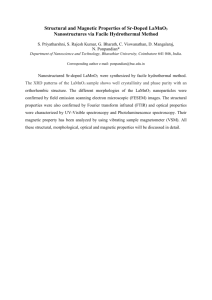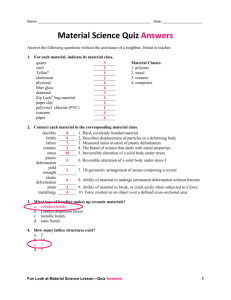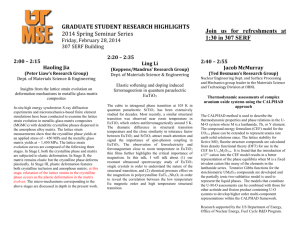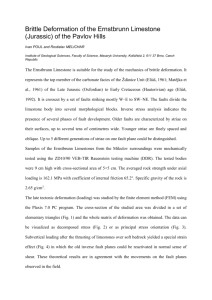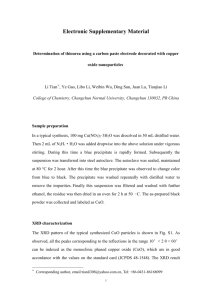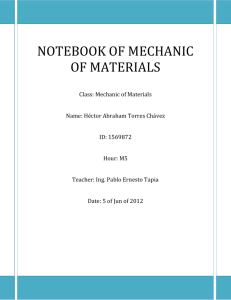Effect of Severe Quasi-Static and Dynamic Deformation on the
advertisement
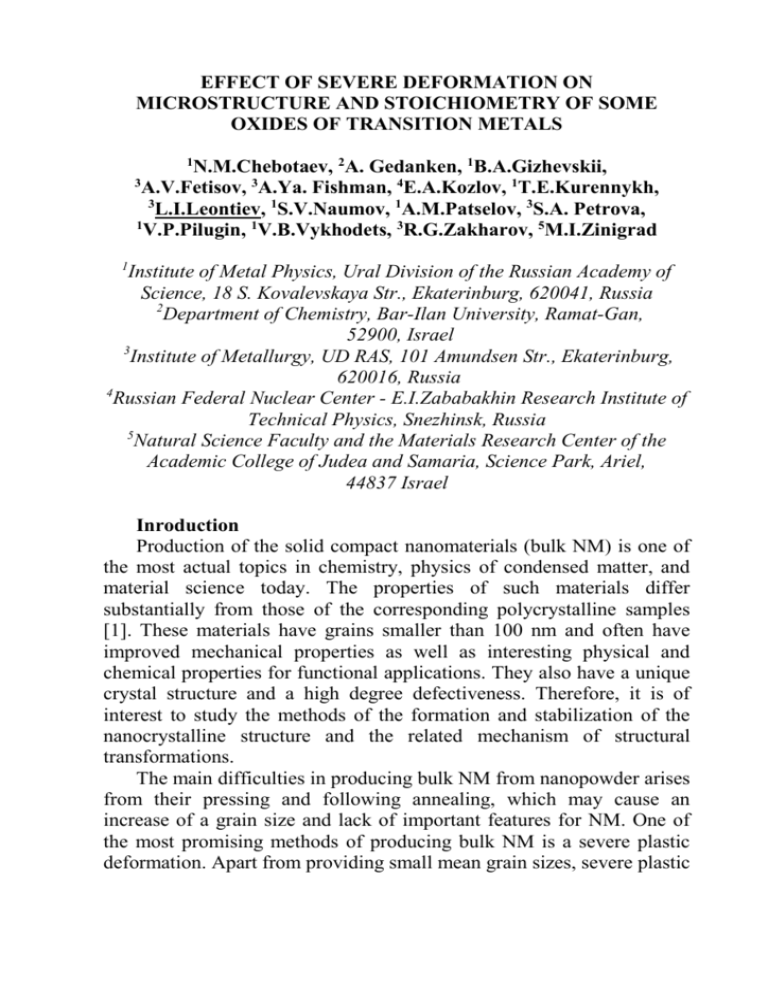
EFFECT OF SEVERE DEFORMATION ON MICROSTRUCTURE AND STOICHIOMETRY OF SOME OXIDES OF TRANSITION METALS 1 N.M.Chebotaev, 2A. Gedanken, 1B.A.Gizhevskii, 3 A.V.Fetisov, 3A.Ya. Fishman, 4E.A.Kozlov, 1T.E.Kurennykh, 3 L.I.Leontiev, 1S.V.Naumov, 1A.M.Patselov, 3S.A. Petrova, 1 V.P.Pilugin, 1V.B.Vykhodets, 3R.G.Zakharov, 5M.I.Zinigrad 1 Institute of Metal Physics, Ural Division of the Russian Academy of Science, 18 S. Kovalevskaya Str., Ekaterinburg, 620041, Russia 2 Department of Chemistry, Bar-Ilan University, Ramat-Gan, 52900, Israel 3 Institute of Metallurgy, UD RAS, 101 Amundsen Str., Ekaterinburg, 620016, Russia 4 Russian Federal Nuclear Center - E.I.Zababakhin Research Institute of Technical Physics, Snezhinsk, Russia 5 Natural Science Faculty and the Materials Research Center of the Academic College of Judea and Samaria, Science Park, Ariel, 44837 Israel Inroduction Production of the solid compact nanomaterials (bulk NM) is one of the most actual topics in chemistry, physics of condensed matter, and material science today. The properties of such materials differ substantially from those of the corresponding polycrystalline samples [1]. These materials have grains smaller than 100 nm and often have improved mechanical properties as well as interesting physical and chemical properties for functional applications. They also have a unique crystal structure and a high degree defectiveness. Therefore, it is of interest to study the methods of the formation and stabilization of the nanocrystalline structure and the related mechanism of structural transformations. The main difficulties in producing bulk NM from nanopowder arises from their pressing and following annealing, which may cause an increase of a grain size and lack of important features for NM. One of the most promising methods of producing bulk NM is a severe plastic deformation. Apart from providing small mean grain sizes, severe plastic deformation can produce poreless massive samples having densities close to the densities of the corresponding coarse-grained or singlecrystal samples, these densities cannot be reached by, for example, compacting nanopowders or hot pressing. Deformation results in a high dislocation density, fine grains (crystallites), and high concentration of point defects and stacking faults. These changes cause the formation of a specific nanostructure. The laws of the formation of the structure during plastic deformation are specified by a combination of parameters of the initial structural state of the material, deformation conditions, and the mechanism of deformation. The methods of severe plastic deformation (such as high pressure torsion, etc) are well designed for metal NM [2]. An application of this technique for oxides gives rise to some obstacles involving changes of the original chemical composition and reduction of oxides up to metal [3,4]. It could be overcome by particular measures, such as: to take the initial oxides with oxygen overbalance (oxygen positive deviation in stoichiomtry), to carry out the experiment under low temperature, etc. These methods need the oxides characterized by a wide homogeneity region, such as lanthanum manganites. Methods for preparation of bulk nanocrystalline oxides To prepare compact nanocrystalline oxide the initial coarse-grain powder of LaMnO3 was subjected to severe plastic deformation by high pressure torsion in Bridgman anvils [5]. This method we name the method of quasi-static deformations. The anvils (fig.1) made of the VK6 WC-Co alloy were 5 mm in diameter. The powder was placed between the anvils and pressed under pressure as high as 9 GPa. The deformation was effected by the rotation of one of the anvils with respect to the other one. The rate of rotation was 0.3-1 rpm. The experiments were carried out at room temperature in air. The degree of strain was specified by the angle of rotation of the anvil [5]. The experimental conditions and the properties of the samples produced are given in the Table 1. The shear strain under pressure caused powder consolidation; as a result, a bulk sample in the form of a biconvex lens, which had a thickness of ~0.12 mm at its center and corresponded to the shape of the high pressure cell, were produced. In some cases the samples exfoliated. For obtaining LaMnO3 nanocrystalline ceramics we also used a shock wave loading (method of dynamic deformations). The spherical explosive systems developed in the Russian Federal Nuclear Center – Research Institute of Technical Physics to produce the materials are the foundation of this method [6]. Shock wave loading (fig.2) performs by a detonation of an explosive on the surface of the spherical sealed casing with the initial material inside. The initial material is a coarse-grain ceramics with a density of 70-80% from the theoretical one. In the process of the loading by spherically convergent shock waves the initial ceramics is compacted up to ~99% from theoretical density and as a result of compression and shear strains we obtain the nano-scale structure with the crystallite sizes of 10-200 nm. By means of this method we prepared a high density nanoceramics of CuO and other oxides [7,8]. The important advantage of the methods of quasi-static and dynamic deformations is a combination of producing nanocrystalline structure and the material compacting one technological process. 1 2 3 1. 2. 3. Starting material Hermetically sealed capsule External jacket Fig.1 A high-pressure plant with a Fig2. A scheme of loading by torsion attachment with (a) and spherical shock waves without (b) restrictive rings: 1-sample, 2-anvils;3-thermocouple Experimental XRD-experiment X-ray diffraction was applied for phase analysis, determination of lattice parameters of phases obtained as well as for crystallite size and lattice strain calculations using Hall-Williamson method [9,10]. XRD studies of the initial and distorted samples were carried out with the automatic diffractometer DRON-UM1 (CuKβ-radiation, the Bragg-Brentano geometry, a pyrographite monochromator on the reflected beam). Patterns were taken in a continuous and scan mode with a step Δ(2θ)=0.02; 0.04 depending on the reflection half-width. For the scan mode exposition time varied from 50 to 200s per step according to the reflection intensity. Silicon with a=0,54309(1)nm was used as an external standard. High pressure torsion deformation was applied to an orthorhombic modification of LaMnO3 (sp.gr.Pnma) with crystal lattice parameters a=0,5655(1) nm, b=0,7722(1) nm, c=0,5528(1) nm. XRD analysis of the initial sample for a shock-wave loading revealed a two-phase mixture of rhombohedral (R 3 c) and cubic (Pm 3 m) phases with lattice parameters aR=0,5522(1) nm, cR=1,3324(2) nm and aC=0,3886(1) nm, correspondingly. XPS study of nanocrystalline LaMnO3 For surface studies of the LaMnO3 samples x-ray photoelectron spectra (Multiprob manufactured by Omicron, MgKα with 1253.6 eV used as an exciting radiation) were taken. Spectra were reduced for charging correction. Measurements were undertaken in a vacuum of 10 -8 mm Hg without preliminary surface purification, as Ar treatment and heating caused changes in the surface conditions. Disturbance of a stoichiometry of CuO nanoceramics Nanocrystalline oxides prepared by the method of dynamic deformations have a high degree nonstoichiometry. Using CuO nanoceramics as an example we investigated this phenomenon by means of nuclear microanalysis and Rutherford back scattering (RBS). A nuclear accelerator complex situated in the Institute of Metal Physics was used to determine a chemical composition of samples. The complex is based on a 2-MV Van de Graaf accelerator. An oxygen content was established by a nuclear microanalysis technique (NM) for the 16O(d,p1)17O reaction, and the Rutherford back scattering (RBS) was used for copper determination. The energy of the initial beam particles was 900keV. A plain surface of a sample was installed perpendicular to the initial beam. Energy spectra from nuclear reaction products were registered by skin-deep silicon detectors at the angle of 160° for both oxygen and copper spectra. For counting protons of the 16O(d,p1)17O reaction a back-scattering deuteron absorber (a lavsan film of 16μm) was mounted. The initial deuteron beam was of 0.5mm in diameter. It determined the size for the analysis zone, over which measured oxygen and copper concentrations were averaged. The number of the initial beam particles caught the sample (radiation dose) was counted by a second monitor of 1% accuracy. It determined a minimum error for the oxygen and copper concentrations measured. Preliminary tests showed an insufficiency of such accuracy for the purposes of the present investigation. Due to this it was decided to refuse separate use of the NM and RBS methods and the reaction products were registered simultaneously on both oxygen and copper nuclei, i.e. under fully equal radiation dose. It allowed us to exclude a radiation dose error from the common precision of composition measurements for the sample surface irradiated. As a result, a root-mean-square error for the oxygen content came to 0.4%. It also must be noted, upon using the experimental scheme described above the analyzed zones for both NM and RBS methods coincided. The oxygen and copper concentrations were calculated from comparison between spectra of a sample under interest and a standard one with an oxygen content constant in depth. The CuO sample with an oxygen content assumed to be 50 % was used as a standard. A dependence of the oxygen content on the distance from the ball center to the external surface was studied. For this purpose a plain sample was cut out from the ceramic ball involved into a shock wave loading. Using the NM and RBS methods the concentration profiles of the elements could be obtained up to a 1μm depth nondestructively. In this connection, all precautions against contaminating surface layers with carbon atoms upon sample cutting were taken. An appropriate monitoring was carried out with the help of the NM method by the 12 C(d,p)13C reaction. No uncontrolled carbon alloyage of the surface layers was established. Sample movement under the beam was made distantly by a step motor with a step 0.7mm. A radiation dose at each measuring point on the sample was 2x1017 deuteron/cm2 and no effects on the chemical composition of the sample were fixed for this dose. A concentration dependence of the oxygen content on the distance from the ball centre is presented in fig.19. Upon treating spectra of nuclear reactions and RBS a total content of the oxygen and copper was assumed as 100%. Results and discussion XRD-studies of the nanocrystalline LaMnO3 Treatment conditions and features of the LaMnO3 samples are collected in the tables 1, 2. Table 1. Treatment conditions and characteristics of the LaMnO3 samples involved into a quasi-static deformation by high pressure torsion Sample Treatment conditions No. 1 2 3 4 5 initial 9ГПа, ω=0,3 φ=60° 9ГПа, ω=0,3 φ=180° 9ГПа, ω=0,3 n=1 9ГПа, ω=0,3 n=3 Crystal lattice parameters, nm a b c 0,56551 0,56482 0,56433 0,56403 0,5641 0,77221 0,77232 0,77223 0,77253 0,7772 0,55281 0,55262 0,55283 0,55293 0,5531 CrystalLattice Volume, lite size strain ε, % 3 <D>, nm nm 0,24141 0,24102 0,24093 0,24093 0,2422 ~μm 22 21 23 23 0,46 0,96 1,20 1,40 Table 2. Treatment conditions and characteristics of the LaMnO3 samples involved into a dynamic deformation by shock wave loading Samp le No. Treatment conditions 6 initial dynamic deformations, centre dynamic deformations, 1114mm from ball centre dynamic deformations, 2023mm from ball centre 7 8 9 X-ray phase analysis Crystal lattice parameters, nm Crystallite size Lattice strain ε, <D>, nm % cR ac R 3 c Pm 3 m aR R 3 c Pm 3 m R 3 c Pm 3 m 75% 25% 0,55221 1,33242 0,38871 ~μm ~μm - 100% - - 0,39011 38 0,21 40% 60% 0,55265 1,33707 0,38895 31 48 0,20 0,38 60% 40% 0,55255 1,34017 0,38865 33 62 0,42 0,68 Figs.3, 4 show parts of the XRD patterns for the initial and distorted samples of LaMnO3. XRD profiles were described by a pseudo-Voigt function. Examples of modeling are presented in figs.5, 6. initial (No.6) exploded, centre (No.7) exploded, periferic (No.9) 2500 1200 (004) initial (No.1) strained (No.4) Intensity, rel.units Intensity, rel.units 2000 800 (220)R (208)R 1500 (220)C 1000 400 500 (410) 60.0 60.5 0 58 59 60 61 62 61.0 61.5 2 63 2 Fig.3. Experimental XRD pattern of the lanthanum manganite samples before and after high pressure torsion for the (410) and (004) reflections 700 strained calculated (410) (004) 600 500 400 300 200 exploded calculated (220)R 1500 (220)C Intensity, rel.units Intensity, rel.units Fig.4. Experimental XRD pattern of the lanthanum manganite samples before and after shockwave loading for the (220)R, (208)R and (220)C reflections. Indexes R and C indicate rhombohedral and cubic phase, correspondingly (208)R 1000 500 100 0 -100 58 59 60 61 62 63 2 Fig.5. Experimental and calculated patterns of the (410) и (004) reflections for quasistatically distorted LaMnO3 (No.4) 0 60.0 60.5 61.0 61.5 2 Fig.6. Experimental and calculated patterns of the (220)R, (208)R and (220)C reflections for dynamically distorted LaMnO3 A value and character of a line broadening at the XRD patterns of the distorted samples as well as an 'express-evaluating' comparison of the ratio between pure physical broadening of the two lines β 2/β1 and tgθ2/tgθ1 or ctgθ2/ctgθ1 proof to be caused by both crystal lattice strain and decreasing a coherent scattering domain size. So, experimental broadening β(2θ) is a sum of size-induced, βs, and strain-induced, βd, broadenings. 0.05 0.09 040 321 211 0.08 123 004 0.07 -1 020 101 200 220 -1 042 022 220 200 *, nm *, nm 0.04 202 002 0.06 111 100 0.05 110 0.03 * =0.04228+0.00512 s 0.04 * =0.02631+0.00212 s 0.03 0 1 2 3 4 5 s,nm 6 7 8 0.02 -1 0 1 2 3 4 s,nm Fig.7 A dependence of the adjusted β*(2θ)=β(2θ)cosθ/λ line broadening on the scattering vector s=2sinθ/λ for the quasistatically distorted LaMnO3 sample (No.2) 7 8 0.07 220 208 024 0.06 0.06 200 220 0.05 211 111 0.05 300 104 012 0.04 110 *, nm -1 -1 006 *, nm 6 Fig.8 A dependence of the adjusted line broadening on the scattering vector for the dynamically distorted LaMnO3 sample (No.7) 018 0.07 5 -1 0.04 100 110 214 202 0.03 0.03 0.02 * =0.02842+0.00431 s * =0.0179+0.00628 s 0.01 0.02 0 1 2 3 4 s,nm 5 6 7 8 -1 Fig.9 A dependence of the adjusted line broadening on the scattering vector for the rhombohedral phase of the dynamically distorted LaMnO3 sample (No.9) 0 1 2 3 4 s,nm 5 6 7 8 -1 Fig.10 A dependence of the adjusted line broadening on the scattering vector for the cubic phase of the dynamically distorted LaMnO3 sample (No.9) To separate size and strain parts of the reflection width the HallWilliamson method was used [9,10]. Figs.7-10 show dependences of an adjusted line broadening β*(2θ) on a scattering vector s=2sinθ/λ for the LaMnO3 samples deformed by both methods. The adjusted broadening was calculated as β*(2θ)=β(2θ)cosθ/λ. The fact, the broadening is increased with an increase of the scattering vector confirms the supposition of two types widening sources. Extrapolating the β*(s) dependence on the β*(s=0) value allows to determine the size-induced part of the broadening. And the strain-induced part can be found directly from the slope of the graph. In the case of the sample involved into a shock-wave loading a phase transition took place in the centre of the ball. As a result a single cubic phase with a=0.3901(2) nm has been formed. For the ‘peripheral’ samples taken far from the ball centre all calculations of the size and strain terms were made separately for each (rhombohedral and cubic) phase. 5.56 c, Å 5.54 5.52 1.35 5.50 1.30 1.25 5.48 7.78 aR,cR,aC,nm 1.20 b,Å 7.76 7.74 0.55 0.50 7.72 0.45 5.66 0.40 0.35 0 5.65 5 10 15 20 25 a, Å r,mm 5.64 0 200 400 600 800 1000 1200 rotation angle , grad Fig.11 A dependence of the crystal lattice parameters on the rotation angle, φ, for the quasi-static deformation by high pressure torsion Fig.12 A dependence of the crystal lattice parameters of the coexisting phases on the distant of the ball centre for the dynamic deformation by shock-wave loading Figs. 11-14 represent dependences of the crystal lattice parameters, crystallite sizes and lattice strains on the distortion conditions. Crystal lattice changes for the samples involved into a shockwave loading are of a certainly anisotropic character. In the samples subjected to a deformation up to n=1 changes in the cell parameters leave crystal lattice volume practically unaltered. On a higher extent of deformation (n=3) a unit cell volume enlarges significantly. It may be probably caused by changes in the deformation character and/or by a decrease of an oxidation number [3,4]. The dynamic deformation of the two-phase sample led to the ratio changes between the two phases without any changes of the lattice parameters (within measurement errors). 65 1050 1000 0.7 <D>C 60 55 50 , % <D>, nm 1.0 900 40 0.5 0.5 45 40 0.4 35 20 0.3 30 25 0 0.2 0.0 0 200 400 600 800 1000 1200 rotation angle , grad <>C 0.6 ,% 950 <D>, nm <>R <D>R 1.5 0 200 400 600 800 1000 1200 rotation angle , grad 20 0 5 10 15 r, mm Fig.13 A dependence of the crystallite size and lattice strain on the rotation angle, φ, during the quasi-static deformation by the high-pressure torsion 20 25 0 5 10 15 20 25 r, mm Fig.14 A dependence of the crystallite size and lattice strain on the distant of the ball centre during the dynamic deformation by the shock-wave loading The quasi-static deformation method brings to a considerably smaller grain size even with a small rotation angle. Further rotating leads as mainly to an increase of the lattice microstrains. As can be seen from the results above, it is interesting to investigate a behavior of quasistatic deformed samples upon slight deformation extent (φ<60°), as well as to study an effect of heavy deformation (with φ>1100°). It is of the particular interest to establish an effect of the rotation speed on a grain size, lattice strains and crystal lattice transformations. For nanocrystal oxides the method of dynamic deformations results in larger crystallite size and less microstrains. It can be connected with high residual temperatures affected a sample after a shock wave loading. XPS study of a nanocrystalline LaMnO3 X-ray photoelectron studies of LaMnO3 surface conditions of the samples involved into high pressure torsion were carried out for the initial orthorhombic modification of LaMnO3 (No.1) and the sample No.2 distorted with a small rotation angle (φ<60°). A mean crystallite size for the nanoscale LaMnO3 was 22 nm and the lattice strain archived 0.46%. The b and c crystal lattice parameters remained nearly unchanged comparatively to the initial sample whereas the a parameters increased slightly (table 1). Spectra of the following elements had been obtained: O1s, Ar2p, N1s, La3d, Mn2p, C и W (figs.15-17). The results are summarized in table3,4. Table 3. Characteristic reflection for the LaMnO3 involved into high pressure torsion. La 3d3/2 ref. 3d sat Sample No.1 851.8 eV 855.4 eV 3+ 4+ 640.7 eV 642.5 eV 1 2 3 4 529.2 eV 531.0 eV 532.3 eV 533.6 eV Sample No.2 853.3 eV 857.4 eV Mn 2p3/2 640.6 eV 643.5 eV O 1s – 531.5 eV 532.8 eV 534.1 eV One can see a remarkable difference between surface conditions of the material before and after distortion both in the basic element content and in adsorbed and impure elements. Compared to the initial state where La and Mn were determined in the equal ratio the distorted sample contained less quantity of the lanthanum. At the same time the amount of the surface carbon increased significantly and argon was detected. It was also established a quantity of the nitrogen (in three different states). Table 4 Chemical content of the samples involved into high pressure torsion calculated with and without oxygen and carbon Sample No.1 frac., at.% Eb,eV 35 0.00 835 2.77 642 3.00 400 3.16 530 65.52 285 25.55 Sample No.1 frac., at.% Eb,eV 35 0.00 835 30.99 642 33.61 400 35.40 - Ref. W4f La3d5/2+3/2 Mn2p3/2 N1s O1s C1s Ar2p1/2+3/2 Ref. W4f La3d5/2+3/2 Mn2p3/2 N1s Ar2p1/2+3/2 526 528 530 532 534 536 538 Энергия связи, эВ Bond energy, eV Fig.15. O 1s - spectrum for the LaMnO3 involved into high pressure torsion: 1-initial No.1, 2-distorted sample No.2 Sample No.2 frac., at.% Eb,eV 35 0.85 835 1.06 642 3.40 400 1.76 530 57.61 285 33.87 248 1.45 Sample No.2 frac., at.% Eb,eV 35 9.99 835 12.47 642 39.89 400 20.70 248 16.96 636 638 640 642 644 646 Энергия связи, эВ eV Bond energy, Fig.16. Mn 2p3/2-spectrum for the LaMnO3 involved into high pressure torsion: 1- initial No.1, 2-distorted sample No.2 The great part of the surface is made up of the oxygen atoms, belonging both to the manganite and to adsorbed compounds. Four oxygen reflections determined at the initial sample (fig.15) are common for the majority of perovskite-like compounds. Three former peaks relate to the basic structure, and in accordance to ample studies the second one contains also carbonate component localized on the surface. O1s peak at 533.6-534.1 eV corresponds to the adsorbed water. By XPS analysis in the distorted samples the tungsten undetected by XRD was also revealed randomly, due perhaps to the anvils made from WC alloy. X-ray photoelectron studies of LaMnO3 surface conditions of the samples involved into shock wave loading were carried out for the initial LaMnO3 sample (No.6) and the sample No.9 from the edge of the ceramics ball. It also revealed changes of the surface content between the initial and distorted samples (tables 5,6) Table 5. Characteristic reflection for the LaMnO3 involved into shock wave loading La 3d3/2 ref. Sample No.6 3d сат 851.8 eV 855.5 eV 3+ 4+ – 642.0 eV Sample No.9 852.1 eV 855.9 eV Mn 2p3/2 848.1 eV (2nd state) 852.2 eV (2nd state) – 642.2 eV O 1s 1 2 3 4 529.4 eV 530.8 eV 532.2 eV 533.7 eV 530.1 eV 531.5 eV 532.6 eV 533.7 eV As with the samples obtained by the high pressure torsion, a decrease of a general oxygen content and noticeable increase of the surface located carbon is distinguished. Surface changes in the element content of the nanoscaled LaMnO3 are connected with a prehistory of the samples as well as with defect peculiarities and adsorption power of the nanocrystalline materials. Table 6 Chemical content of the samples involved into shock wave loading calculated with and without oxygen and carbon W4f La3d5/2+3/ 2 Mn2p3/2 N1s O1s C1s Ar W4f La3d5/2+3/ 2 Mn2p3/2 N1s Ar 830 35 0.00 35 0.00 835 642 400 530 285 243 1.72 8.20 9.23 79.01 0.72 1.12 835 642 400 530 285 244 1.05 1.12 7.58 54.59 35.47 0.19 Sample No.9 frac., at.% Sample No.6 frac., at.% ref. 825 Sample No.9 frac., at.% Eb,eV Sample No.6 frac., at.% Eb,eV ref. 835 840 Eb,eV 35 835 642 400 243 845 850 855 0.00 Eb,eV 35 0.00 8.49 40.44 45.54 5.52 835 642 400 244 10.58 11.23 76.25 1.94 860 865 Энергия связи, эВ Bond energy, eV Fig. 17. La 3d -spectrum for the LaMnO3 involved into high 825 830 835 840 845 850 855 860 Энергия связи, eV эВ Bond energy, Fig. 18. La 3d -spectrum for the LaMnO3 involved into 865 pressure torsion: 1–initial No.1, shock wave loading: 1–initial 2-distorted No.2 No.6, 2-distorted No.9 The absence of the low-energy structural oxygen peak at the spectrum of the nanoscaled sample No.9 points probably to a huge carbonate group allocating on the sample surface or indicates (as supposed by authors) some changes in the basic oxygen structural positions. In the sample obtained by dynamic deformations with shock wave loading a light shift of the lanthanum peaks up to the high energy side is observed. For the oxygen peaks this movement is even more obvious. The lanthanum second state (fig.18) discovered in the nanocrystalline sample No.9 is probably relative to the metal lanthanum. (probably caused by a two-phase state of the oxide.) Disturbance of a stoichiometry of CuO nanoceramics It is known that CuO is compound having narrow region of homogeneity. In equilibrium under normal conditions copper monoxide has departure from stoichiometric composition CuO less as 1% [11]. Our investigations show that the ratio of concentrations oxygen and copper CO/CCu varies strongly along the radius of the compressed CuO nanoceramic ball (Fig. a). In our case the radius of CuO ball is about 23 mm. In the outer layers of the ball oxygen concentration CO is bigger than copper concentration CCu up to several percentages. Variation of CO and CCu is slightly different along varies radiuses. Maximum difference of CO and CCu reaches 6-8%. These compositional data are confirmed by chemical analysis produced by methods of titration and H2-reduction. It must be emphasized that such kind disturbance of composition is observed in monohpase CuO nanoceramics. Precision XRD measurements and X-ray emission spectroscopy study do not reveal any second phases in our nanoceramics. We note that special thermotreatments and quenches can’t change CuO composition so strongly [a]. Possible reasons of such kind disturbance may be synthesis of peroxide ions (O-O)2- or/and formation of solid solution of CuO and O. We have not reliable information about existence these compounds but the possibility formation of these compounds under high pressure of oxygen was considered in [12]. In our experiments loading of CuO blank by spherically convergent shock waves gives rise to high pressure and temperature. In central part of the blank at the radius R<1 mm pressure reaches some megabars. Under extremal conditions decomposition of CuO occurs partially on Cu2O and O. Free oxygen is under high pressure in the germetically sealed casing and initiates formation of peroxide or solid solution. Fig.19 A dependence of the oxygen/copper ratio on the distance from the surface of the nanoceramic ball. CuO 1.06 1.05 Ratio CO/CCu 1.04 1.03 1.02 1.01 1.00 0.99 0.98 0 1 2 3 4 5 6 7 8 Distance from sample edge,mm Conclusion Analysis of the data obtained confirms both distortion methods permit to produce volumetric nano-scale materials, including lanthanum manganite, from the coarse-grained powder during a single technological cycle. Whereas thin plates obtained by the quasi-static deformation are not always strong enough this method brings to a considerably smaller grain size even with a small rotation angle. Further rotating leads as mainly to an increase of the lattice microstrains. As a merit of the dynamical deformation method a high density (up to 99%) and good mechanical properties can be considered. Moreover, this technique permits to get comparatively great amount of the material during one processing cycle. Besides LaMnO3, bulk nanocrystalline materials based on TiO and ZrO2:Y2O3 (YSZ) were obtained by the quasi-static deformation technique [13,14]. In these oxydes XRD analysis revealed a decrease of crystallite size (up to ~100 nm) and an increase of lattice microstrains started at the rotation angles of 15-20о. At the same time, a constant dispersibility of the microstructure is achieved in 2 turns for the TiO and in one turn for the YSZ case. And the TiO ceramics is characterized by a non-monotone dependence of the microstrain on the rotation angle. At the high extent of deformations and small crystallite size the strain value decreases, probably due to more efficient stress relaxation through a grain-boundary slipping when decreasing crystallite size. For the TiO oxide an increase of a deformation rate led to an increase of a cubic cell parameter. This indicates significant changes of the crystal lattice point defect upon severe plastic deformation of the titanium monoxide. Such a behavior could be caused by a shutting down (annihilating) oxygen and titanium vacancies during high pressure torsion and/or by changing the oxygen content. Nanoscaled ceramics of CuO and Mn3O4 were produced by the dynamic deformations [7,8]. According to the data obtained by XRD, SEM and STM the crystallite size of the CuO nanoceramics was 10-100 nm and 50-200 nm for the Mn3O4. Certain regularity of the crystallite size could be observed along the radius of the nanoceramic ball. The density of the nanoceramics comes to 99%. Size effects and specific imperfection of the ceramics obtained lead to a set of particularities of physical properties [16,17,18,19]. Acknowledgment The financial support from the Russian Foundation for Basic Research is gratefully acknowledged (project No.04-03-34971) Literature 1. H. Gleiter, Acta Mater. 48, 1-29 (2000) 2. R.Z. Valiev and I.V. Alexandrov, Nanostructured Materials Obtained by Severe Plastic Deformation, Logos, Moscow, 2000 (in Russian) 3. L.F. Vereshchagin, E.V. Zubova, K.P. Burdina, and G.L. Aparnukov, Dokl. Akad. Nauk SSSR, 196, 817-818(1971) 4. D.A. Zatsepin, V.R. Galakhov, B.A. Gizhevskii, en al., Phys. Rev. B, 59, 211 (1999) 5. D.I.Tupitsa, V.P. Pilyugin, R.I. Kuznetsov, et al., Fiz. Met. Metallved., 61, 325-330 (1986) 6. E.A. Kozlov, E.V. Abakshin, V.I. Tarzhanov, Patent of Russian Federation No2124716 of 24.12.97 7. B.A. Gizhevskii, E.A. Kozlov, A.E. Yermakov, et al., Phys.Met.Metallog.,92, 153-157 (2001) 8. B.A. Gizhevskii, E.A. Kozlov, V.R. Galakhov, et al., “Nanoparticles, Nanostructures, Nanocomposites” Topical Meeting 9. 10. 11. 12. 13. 14. 15. 16. 17. 18. 19. of European Ceramics Society, July 5-7, 2004, S.-Petersburg, Russia, Abstracts, p.89 G.K.Williamson, W.H.Hall, Acta Metallurgica 1 (1953) 22. H.P.Klug, L.Alexander, X-ray Diffraction Procedure for Polycrystalline and Amorphous Materials (Wiley, New York, 1974) V.B.Vykhodets, S.M.Klotsman,T.E.Kurennykh et al: The Physics of Metal and Metallography Vol. 63 (1987), pp. 974- 980. V.B.Vykhodets, S.M.Klotsman, A.D.Levin: The Physics of Metal and Metallography Vol.64 (1987), pp. 920- 924. A.A. Valeeva, B.A. Gihevskii, V.P. Pilyugin, A.A. Rempel, Phys. Metal. Metallog. 99, 62-68 (2005) B.A. Gihevskii, et al.,Conference “Nanotechnology and physics of functional nanomaterials”, April 18-22, 2005, Ekaterinburg, Russia. Abstracts, p.76-77 (in Russian) V.I.Voronin, L.Z.Akhtyamova, I.F.Berger, B.A.Gigevskii, E.A.Kozlov, S.V.Naumov, Y.G.Chukalkin, B.N.Goshchitskii. 3-rd European Conference on Neutron Scattering ECNS – 2003, September 3-6, 2003, Montpellier, France. Abstract book, p.80 A.P.Druzhkov, B.A.Gizhevskii, V.L.Arbuzov, E.A.Kozlov, K.V.Shalnov, D.A.Perminov. J. Phys.: Condens. Matter. 2002, v.14, p.7981-7990. T.I.Arbuzova, B.A.Gizhevskii, S.V.Naumov, A.V.Korolev, V.L.Arbuzov, K.V.Shalnov, A.P.Druzhkov. JMMM, 2003, 258-259, 342-444. B.A. Gizhevskii, Yu.P. Sukhorukov, N.N. Loskareva, A.S. Moskvin, E.V. Zenkov, E.A. Kozlov. J. Phys.: Condens. Matter. 17, 499 (2005). T.I.Arbuzova, B.A.Gizhevskii, S.V.Naumov, V.L.Arbuzov, K.V.Shalnov, E.A.Kozlov, N.V.Kostromitina. Proc.of the XVIII Int. Conf. «New magnetic materials for microelectronics», June 24-28 2002, Moscow, с.288-290 (in Russian).
